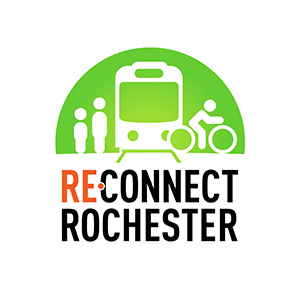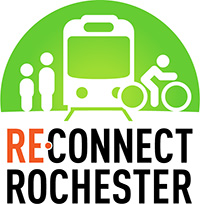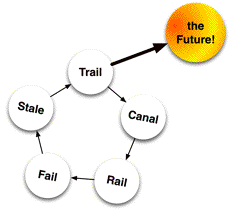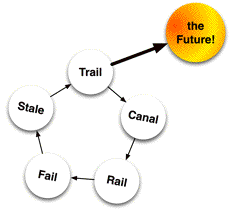
Rochester’s routes have shaped its history and will determine its destiny. From its Native American days to the present, Rochester’s historical pathways continue to shape and affect its vibrancy. We’ve come full circle.
Trail. Indian trails shaped today’s street arrangement. Instead of a simple urban grid we have Genesee Street, Plymouth Avenue and the trail along the east bank of the Genesee River.
Canal. Our nineteenth-century canal system built on these Native American routes. The largely-forgotten Genesee Valley Canal followed closely South Plymouth Avenue and the Feeder Canal paralleled much of today’s Mt. Hope Avenue. The Erie Canal followed a curving West Broad Street route as it entered downtown.
Rail. Starting in 1878, railroads began supplanting canals. Five different railroad systems operated in downtown Rochester around the early 1900s.
Fail. But interstate highways, suburban development, governmental policy, and automobile lobbies eventually supplanted the dominance of the railroads.
Stale. In the 1970s, urban redevelopment gave us the Inner Loop, suburban sprawl, and neighborhood separation. Subsequently, the city economi staled and people moved elsewhere. Many of Rochester’s core urban neighborhoods inherited surplus housing beyond reclaiming.
Trail! New hope now comes with the City of Rochester’s Project Green. The idea is to turn swaths of vacant and substandard housing into greenspaces that will enhance property values and quality of life. Some greenspaces would be used for community gardens. Some greenspaces would be “land-banked” for future development when the economy improves. And some greenspaces will be developed as linear parks for pedestrian and bicycle reconnecting neighborhoods, encouraing active living, reducing carbon footprints and parking pressures, combatting obesity, and generally making life better!
The Rochester Cycling Alliance strongly supports the City’s efforts to re-envision and re-provision former canal and rail routes, and to develop a bicycle master plan that uses them to reconnect and re-invigorate our city.
Rochester will blaze new trails by recovering old ones. Bike to the future!









